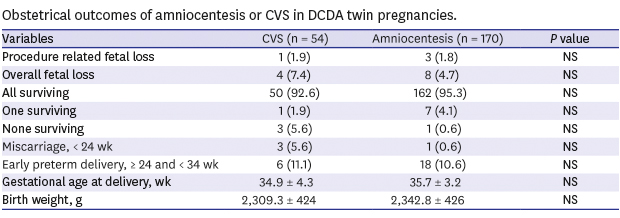1. van de Mheen L, Everwijn SM, Knapen MF, Haak MC, Engels MA, Manten GT, et al. Pregnancy outcome after fetal reduction in women with a dichorionic twin pregnancy. Hum Reprod. 2015; 30(8):1807–1812.

2. Elster N. Less is more: the risks of multiple births. Fertil Steril. 2000; 74(4):617–623.

3. Kan AS, Lee CP, Leung KY, Chan BC, Tang MH, Chan VH. Outcome of twin pregnancies after amniocentesis. J Obstet Gynaecol Res. 2012; 38(2):376–382.

4. Simonazzi G, Curti A, Farina A, Pilu G, Bovicelli L, Rizzo N. Amniocentesis and chorionic villus sampling in twin gestations: which is the best sampling technique? Am J Obstet Gynecol. 2010; 202(4):365.e1–365.e5.

5. Antsaklis A, Souka AP, Daskalakis G, Kavalakis Y, Michalas S. Second-trimester amniocentesis vs. chorionic villus sampling for prenatal diagnosis in multiple gestations. Ultrasound Obstet Gynecol. 2002; 20(5):476–481.

6. Weisz B, Rodeck CH. Invasive diagnostic procedures in twin pregnancies. Prenat Diagn. 2005; 25(9):751–758.

7. Enzensberger C, Pulvermacher C, Degenhardt J, Kawecki A, Germer U, Weichert J, et al. Outcome after second-trimester amniocentesis and first-trimester chorionic villus sampling for prenatal diagnosis in multiple gestations. Ultraschall Med. 2014; 35(2):166–172.

8. Agarwal K, Alfirevic Z. Pregnancy loss after chorionic villus sampling and genetic amniocentesis in twin pregnancies: a systematic review. Ultrasound Obstet Gynecol. 2012; 40(2):128–134.

9. Lenis-Cordoba N, Sánchez MA, Bello-Muñoz JC, Sagalá-Martinez J, Campos N, Carreras-Moratonas E, et al. Amniocentesis and the risk of second trimester fetal loss in twin pregnancies: results from a prospective observational study. J Matern Fetal Neonatal Med. 2013; 26(15):1537–1541.

10. Yukobowich E, Anteby EY, Cohen SM, Lavy Y, Granat M, Yagel S. Risk of fetal loss in twin pregnancies undergoing second trimester amniocentesis(1). Obstet Gynecol. 2001; 98(2):231–234.
11. Millaire M, Bujold E, Morency AM, Gauthier RJ. Mid-trimester genetic amniocentesis in twin pregnancy and the risk of fetal loss. J Obstet Gynaecol Can. 2006; 28(6):512–518.

12. Cahill AG, Macones GA, Stamilio DM, Dicke JM, Crane JP, Odibo AO. Pregnancy loss rate after mid-trimester amniocentesis in twin pregnancies. Am J Obstet Gynecol. 2009; 200(3):257.e1–257.e6.

13. Seo BK, Chung JH, Yang JH, Shin JS, Kim MY, Ryu HM, et al. Fetal loss rate after midtrimester amniocentesis in twin pregnancies. Korean J Obstet Gynecol. 2006; 49(6):1204–1211.
14. Wapner RJ, Johnson A, Davis G, Urban A, Morgan P, Jackson L. Prenatal diagnosis in twin gestations: a comparison between second-trimester amniocentesis and first-trimester chorionic villus sampling. Obstet Gynecol. 1993; 82(1):49–56.

15. Lee YJ, Kim MN, Kim YM, Sung JH, Choi SJ, Oh SY, et al. Perinatal outcome of twin pregnancies according to maternal age. Obstet Gynecol Sci. 2019; 62(2):93–102.

16. Akolekar R, Beta J, Picciarelli G, Ogilvie C, D'Antonio F. Procedure-related risk of miscarriage following amniocentesis and chorionic villus sampling: a systematic review and meta-analysis. Ultrasound Obstet Gynecol. 2015; 45(1):16–26.

17. Antsaklis A, Papantoniou N, Xygakis A, Mesogitis S, Tzortzis E, Michalas S. Genetic amniocentesis in women 20–34 years old: associated risks. Prenat Diagn. 2000; 20(3):247–250.

18. Alfirevic Z, Navaratnam K, Mujezinovic F. Amniocentesis and chorionic villus sampling for prenatal diagnosis. Cochrane Database Syst Rev. 2017; 9:CD003252.

19. Bakker M, Birnie E, Robles de Medina P, Sollie KM, Pajkrt E, Bilardo CM. Total pregnancy loss after chorionic villus sampling and amniocentesis: a cohort study. Ultrasound Obstet Gynecol. 2017; 49(5):599–606.

20. Wulff CB, Gerds TA, Rode L, Ekelund CK, Petersen OB, Tabor A, et al. Risk of fetal loss associated with invasive testing following combined first-trimester screening for Down syndrome: a national cohort of 147,987 singleton pregnancies. Ultrasound Obstet Gynecol. 2016; 47(1):38–44.
21. Niederstrasser SL, Hammer K, Möllers M, Falkenberg MK, Schmidt R, Steinhard J, et al. Fetal loss following invasive prenatal testing: a comparison of transabdominal chorionic villus sampling, transcervical chorionic villus sampling and amniocentesis. J Perinat Med. 2017; 45(2):193–198.

22. Daskalakis G, Antsaklis P, Gourounti K, Theodora M, Sindos M, Papantoniou N, et al. Chorionic villus sampling in assisted versus spontaneous conception twins. Ultraschall Med. 2017; 38(4):437–442.

23. De Catte L, Liebaers I, Foulon W. Outcome of twin gestations after first trimester chorionic villus sampling. Obstet Gynecol. 2000; 96(5 Pt 1):714–720.

24. Egan E, Reidy K, O'Brien L, Erwin R, Umstad M. The outcome of twin pregnancies discordant for trisomy 21. Twin Res Hum Genet. 2014; 17(1):38–44.

25. Sebire NJ, Snijders RJ, Santiago C, Papapanagiotou G, Nicolaides KH. Management of twin pregnancies with fetal trisomies. Br J Obstet Gynaecol. 1997; 104(2):220–222.

26. Fernandes TR, Carvalho PR, Flosi FB, Baião AE, Junior SC. Perinatal outcome of discordant anomalous twins: a single-center experience in a developing country. Twin Res Hum Genet. 2016; 19(4):389–392.

27. Gedikbasi A, Akyol A, Yildirim G, Ekiz A, Gul A, Ceylan Y. Twin pregnancies complicated by a single malformed fetus: chorionicity, outcome and management. Twin Res Hum Genet. 2010; 13(5):501–507.

28. Hack KE, Derks JB, Elias SG, Franx A, Roos EJ, Voerman SK, et al. Increased perinatal mortality and morbidity in monochorionic versus dichorionic twin pregnancies: clinical implications of a large Dutch cohort study. BJOG. 2008; 115(1):58–67.

29. Nassar AH, Adra AM, Gómez-Marín O, O'Sullivan MJ. Perinatal outcome of twin pregnancies with one structurally affected fetus: a case-control study. J Perinatol. 2000; 20(2):82–86.















